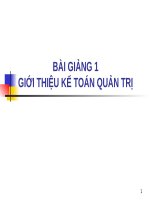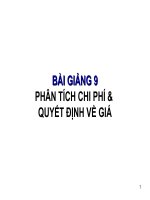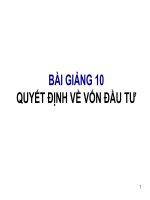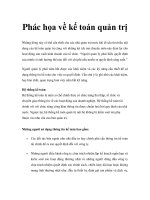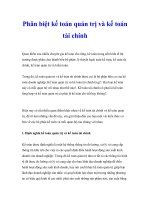ch02 Job Order Costing Ke toan quan tri
Bạn đang xem bản rút gọn của tài liệu. Xem và tải ngay bản đầy đủ của tài liệu tại đây (1.16 MB, 67 trang )
Page
2-1
Job Order Costing
Managerial Accounting
Fifth Edition
Weygandt Kimmel Kieso
Page
2-2
study objectives
Page
2-3
1.
Explain the characteristics and purposes of cost
accounting.
2.
Describe the flow of costs in a job order costing
system.
3.
Explain the nature and importance of a job cost
sheet.
4.
Indicate how the predetermined overhead rate is
determined and used.
5.
Prepare entries for jobs completed and sold.
6.
Distinguish between under- and overapplied
manufacturing overhead.
preview of chapter 2
Page
2-4
Cost
Cost Accounting
Accounting Systems
Systems
Cost Accounting involves:
Measuring,
Recording, and
Reporting of product costs
Accounts are fully integrated into the general
ledger.
Perpetual inventory system provides immediate,
up-to-date information.
Page
2-5
Two basic types: (1) a job order cost system
and (2) a process cost system.
SO 1 Explain the characteristics and purposes of cost accounting.
Cost
Cost Accounting
Accounting Systems
Systems
Job Order Cost System
Costs are assigned to each job or batch.
A job may be for a specific order or inventory.
A key feature: Each job or batch has its own
distinguishing characteristics.
The objective: To compute the cost per job.
Measures costs for each job completed – not for
set time periods.
Page
2-6
SO 1 Explain the characteristics and purposes of cost accounting.
Cost
Cost Accounting
Accounting Systems
Systems
Illustration 2-1
Page
2-7
SO 1 Explain the characteristics and purposes of cost accounting.
Cost
Cost Accounting
Accounting Systems
Systems
Process Cost System
Used when a large volume of similar products
are manufactured - (Cereal, Automobiles, Compact
Discs, Paint).
Costs are accumulated for a specific time period
– (week or month).
Costs are assigned to departments or processes
for a set period of time.
Page
2-8
SO 1 Explain the characteristics and purposes of cost accounting.
Cost
Cost Accounting
Accounting Systems
Systems
Illustration 2-2
Page
2-9
SO 1 Explain the characteristics and purposes of cost accounting.
Cost
Cost Accounting
Accounting Systems
Systems
Review
Question
Cost accounting involves the measuring,
recording, and reporting of:
a. Product costs.
b. Future costs.
c. Manufacturing processes.
d. Managerial accounting decisions.
Page
2-10
Solution on
notes
SOpage
1 Explain
the characteristics and purposes of cost accounting.
Job
Job Order
Order Cost
Cost Flow
Flow
The cost flow parallels the physical flow of the
materials as they are converted into finished goods
Manufacturing costs are assigned to Work in
Process.
Cost of completed jobs is transferred to Finished
Goods.
When units are sold, the cost is transferred to Cost
of Goods Sold.
Page
2-11
SO 2 Describe the flow of costs in a job order costing system.
Job
Job Order
Order Cost
Cost Flow
Flow
Illustration 2-3
Page
2-12
SO 2 Describe the flow of costs in a job order costing system.
Job
Job Order
Order Cost
Cost Flow
Flow
Illustration 2-4
Page
2-13
SO 2
Job
Job Order
Order Cost
Cost Flow
Flow
Accumulating Manufacturing Costs
Raw Material Costs
Illustration: Wallace Manufacturing purchases 2,000
handles (Stock No. AA2746) at $5 per unit ($10,000)
and 800 modules (Stock No. AA2850) at $40 per unit
($32,000) for a total cost of $42,000 ($10,000 +
$32,000). The entry to record this purchase on January
4 is:
Jan. 4
Raw Materials Inventory
42,000
Accounts Payable
Page
2-14
42,000
SO 2 Describe the flow of costs in a job order costing system.
Job
Job Order
Order Cost
Cost Flow
Flow
Factory Labor Costs
Consists of three costs:
1. Gross earnings of factory workers,
2. Employer payroll taxes on these earnings, and
3. Fringe benefits incurred by the employer.
Page
2-15
SO 2 Describe the flow of costs in a job order costing system.
Job
Job Order
Order Cost
Cost Flow
Flow
Factory Labor Costs
Illustration: Wallace Manufacturing incurs $32,000 of
factory labor costs. Of that amount, $27,000 relates to
wages payable and $5,000 relates to payroll taxes payable
in February. The entry to record factory labor for the month
is:
Jan. 31 Factory Labor
32,000
Factory Wages Payable
Employer Payroll Taxes Payable
Page
2-16
27,000
5,000
SO 2 Describe the flow of costs in a job order costing system.
Job
Job Order
Order Cost
Cost Flow
Flow
Manufacturing Overhead Costs
Many types of overhead costs
For example, machinery repairs, indirect
materials, and indirect labor
Debit to Manufacturing Overhead
Daily as incurred or
Periodically through adjusting entries
Manufacturing overhead is a control account
Page
2-17
Subsidiary ledger consists of individual accounts
for each type of cost
SO 2 Describe the flow of costs in a job order costing system.
Job
Job Order
Order Cost
Cost Flow
Flow
Manufacturing Overhead Costs
Illustration: Using assumed data, the summary entry for
manufacturing overhead in Wallace Manufacturing
Company is:
Jan. 31 Manufacturing Overhead
13,800
Page
2-18
Utilities Payable
4,800
Prepaid Insurance
2,000
Accounts Payable (for repairs)
2,600
Accumulated Depreciation
3,000
Property Taxes Payable
1,400
SO 2 Describe the flow of costs in a job order costing system.
Job
Job Order
Order Cost
Cost Flow
Flow
During the current month, KRC Company
incurs the following manufacturing costs:
(a) Raw material purchases of $4,200 on account.
(b) Incurs factory labor of $18,000. Of that amount,
$15,000 relates to wages payable and $3,000 relates
to payroll taxes payable.
(c) Factory utilities of $2,200 are payable, prepaid factory
insurance of $1,800 has expired, and depreciation on
the factory building is $3,500.
Prepare journal entries for each type of manufacturing cost.
Page
2-19
SO 2 Describe the flow of costs in a job order costing system.
Job
Job Order
Order Cost
Cost Flow
Flow
Prepare journal entries for each type of
manufacturing cost.
(a) Raw material purchases of $4,200 on account.
Raw Materials Inventory
Accounts Payable
4,200
4,200
(b) Incurs factory labor of $18,000. Of that amount,
$15,000 relates to wages payable and $3,000 relates
to payroll taxes payable..
Page
2-20
Factory Labor
18,000
Factory Wages Payable
Employer Payroll Taxes Payable
15,000
3,000
SO 2
Job
Job Order
Order Cost
Cost Flow
Flow
Prepare journal entries for each type of
manufacturing cost.
(c) Factory utilities of $2,200 are payable, prepaid factory
insurance of $1,800 has expired, and depreciation on
the factory building is $3,500.
Manufacturing Overhead
Page
2-21
7,500
Utilities Payable
2,200
Prepaid Insurance
1,800
Accumulated Depreciation
3,500
SO 2 Describe the flow of costs in a job order costing system.
Job
Job Order
Order Cost
Cost Flow
Flow
Review
Question
When incurred, factory labor costs are debited to:
a. Work in Process.
b. Factory Wages Expense.
c. Factory Labor.
d. Factory Wages Payable.
Solution on
notes page
Page
2-22
SO 2 Describe the flow of costs in a job order costing system.
Job
Job Order
Order Cost
Cost Flow
Flow
Assigning Manufacturing Costs to Work in
Process
Manufacturing costs are assigned to Work in Process
with
Debits to
Work in Process Inventory
Credits to
Raw Materials Inventory
Factory Labor
Manufacturing Overhead
Entries to Work in Process are usually made monthly.
Page
2-23
An essential accounting record in assigning costs to
jobs is a job cost sheet.
SO 3 Explain the nature and importance of a job cost sheet.
Job
Job Order
Order Cost
Cost Flow
Flow
Job Cost Sheet
Used to record costs of a specific job.
Used to determine the total and unit costs of a
completed job.
Each entry to a Work in Process Inventory must be
accompanied by a corresponding posting to one or
more job cost sheets.
Page
2-24
SO 3 Explain the nature and importance of a job cost sheet.
Job
Job Order
Order Cost
Cost Flow
Flow
Job Cost Sheet
Page
2-25
Illustration 2-5
SO 3 Explain the nature and importance of a job cost sheet.
